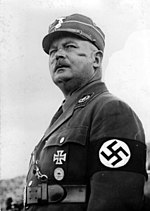"เนื้อหาดังกล่าวไม่เหมาะสมสำหรับคนบางวัย อาจะมีภาพ และเนื้อหาที่รุนแรงจนคนบางกลุ่มรับไม่ได้ โปรดใช้วิจารณญาณในการรับชม"
แผนมาดากัสกา Madagascar Plan เป็นข้อเสนอของรัฐบาลนาซีของเยอรมนีจะย้ายประชากรชาวยิวของยุโรปไปยังเกาะมาดากัสการ์
 Franz Rademacher,
Franz Rademacher,
หัวหน้าภาควิชายิวของกระทรวงการต่างประเทศของรัฐบาลนาซี เสนอความคิดดังกล่าวในเดือนมิถุนายนปี 1940 ก่อนที่ความฝรั่งเศสจะพ่ายแพ้ ข้อเสนอเรียกร้องให้พาชาวยิวมาดากัสการ์
การส่งชาวยิวโปแลนด์ไปมาดากัสการ์ได้รับการตรวจสอบโดยรัฐบาลโปแลนด์ในปี 1937 แต่การประเมินศักยภาพของเนื้อที่เกาะแล้วจะรองรับได้เพียง 5,000 ถึง 7,000 ครอบครัวเท่านั้นเอง
ภายหลังความคิดของชาวยิวการส่งยิวไปมาดากัสการ์ก็ถูกรื้อฟื้นขึ้นมาโดยรัฐบาลนาซีในปี 1940 ทั้งๆที่มีเนื้อที่จำกัด ของเกาะเพื่อสนับสนุนการดำรงชีวิตของมนุษย์
Rademacher แนะนำเรื่องนี้ในวันที่ 3 มิถุนายน 1940 ว่าที่มาดากัสการ์ควรจะทำเป็นที่อยู่สำหรับชาวยิวในยุโรป
ด้วยความเห็นชอบของอดอล์ฟ ฮิตเลอร์และ อดอล์ฟ ไอชแมน ออกบันทึกที่ 15 สิงหาคม 1940 เรียกร้องให้มี การตั้งถิ่นฐานของชาวยิวนับล้านคนต่อปี โดยใช้เวลาสี่ปี และควบคุมเป็นรัฐตำรวจภายใต้การควบคุมของเอสเอส
แผนถูกเลื่อนออกไปหลังจากที่เยอรมันล้มเหลวที่จะเอาชนะอังกฤษในการต่อสู้กับสหราชอาณาจักรต่อมาในปี 1940 และได้รับการบุคคลากรอย่างถาวรในปี 1942 ที่มีการเริ่มการขุดรากถอนโคนของยุโรปทั้งหลาย
จุดเริ่มต้น
ในช่วงปลายยุค 1800 และต้นปี 1900 มีจำนวนของแผนการตั้งถิ่นฐานชาวยิวในยุโรปที่เป็นต้นเหตุในการจัดทำแผนมาดากัสการ์ พอลเดอ Paul de Lagarde นักวิชาการแนะนำเรื่องนี้โดยอพยพชาวยิวในยุโรปเพื่อมาดากัสการ์ในปี 1885สมาชิกของขบวนการ ซีออน(Zionist) ใน 1904-1905 ถกเถียงกันอย่างจริงจังเรื่อง โครงการชาวอังกฤษ-ยูกันดา โดยที่รัสเซีย(ยิว) มีปัญหาทันทีจากชาติพันธุ์อย่างต่อเนื่องจะได้รับการตัดสินในยูกันดา แผนถูกปฏิเสธในภายหลังว่าเรื่องนี้มันเป็นไปไม่ได้โดย วุฒิสภาคองเกรส ซีออน(Zionist)
(ในรูป ชาว Semite)
ความคิดของการตั้งถิ่นฐานของชาวยิวที่ถูกนำตัวขึ้นมาในช่วงปี ค.ศ. 1920 โดยพวกต่อต้านSemite และอื่น ๆ ด้วยความร่วมมือกับฝรั่งเศส รัฐบาลโปแลนด์ได้ทำการะสำรวจในปี 1937
ตรวจสอบถึงความเป็นไปได้ที่จะส่งยิวไปในเกาะ มาดากัสการ์ แต่ผลกลับกลายเป็นว่ารับได้ไม่เพียงพอ
ในนาซีเยอรมัน
เชื้อชาติอารยันคือสิ่งสูงสุด เป็นหลักการพื้นฐานของพรรคนาซีและรัฐบาลนาซี. การเลือกปฏิบัติและการโจมตีอย่างรุนแรงกับชาวยิวเริ่มทันทีหลังจากที่ยึดอำนาจในปี 1933 ความรุนแรงและความดันทางเศรษฐกิจถูกนำมาใช้โดยพวกนาซีที่จะส่งเสริมให้ชาวยิวที่จะส่งเสริมให้สมัครใจออกจากประเทศในปี 1939 ประมาณ 250,000 คนในเยอรมัน และยิว 43,700 คนอพยพหนีไป อเมริกา อาเจนตินา อังกฤษ ปาเลสไตน์ และอีกหลายๆประเทศ
คนในพรรคนาซีมากมายยังคงยึดติดกับไอเดียร์ที่จะเนรเทศพวกยิวออกไปจากประเทศ
ยูเรียส สไตรเชอร์
โยฮาคอม ฟอน ริบเบนทรอบ
ไฮนดริช ฮิมเลอร์
อัลเฟรด โรเซนเบิร์ก
เฮอร์มาน เกอร์ริง
แผนการ
ซึ่งการประชุมครั้งนี้เกิดขึ้นในพลพรรคนาซีซึ่งมี จูเลียส สไตรคเชอร์ เฮอแมน เกอร์ริง อัลเฟรด โรเซนเบิร์ก และ โยฮาคิม ฟอน ริบเบนท็อป จนกระทั่ง ปี 1940 เรื่องแผนก็เริ่มจะได้ฤกดิ์ ฟรานซ์ ลาเดอร์มาเชอร์ ได้รับการแต่งตั้งให้เป็นผู้ดูแล ยิว ในสำนักงานกระทรวงการต่างประเทศ ใน3วันให้หลัง คนใหญ่คนโต มาร์ติน ลูเธอร์(ไม่ใช่คนดำ หรือนักเคลื่อนไหวศาสนานะครับ)
ฟรานซ์ ลาเดอมานเชอร์
มาร์ติน ลูเธอร์
ลาเดอร์มาชเชอร์ ได้เขียนใว้ในบันทึกของเขาเกี่ยวกับชะตากรรมของชาวยิวว่า "การแก้ปัญหาที่น่าพอใจของชาติคือชาวยิวจะต้องออกไปจากยุโรป" มาร์ติน ได้แนะนำว่ามาดากัสการ์ อาณานิคมของฝรั่งเศส ควรจะทำที่อยู่ให้สำหรับชาวยิวในยุโรปเป็นหนึ่งในเงื่อนไขของการยอมจำนนของฝรั่งเศสซึ่งเยอรมันได้รุกรานฝรั่งเศสในวันที่ 10 พฤษภาคม 1940
ลาเดอร์มาชเชอร์ กล่าวว่าการทำที่อยู่ใหม่ให้ยิวอยู่ เป็นการกระทำที่ดีในอนาคตสำหรับเพื่อนร่วมชาติในอเมริกา
ในบันทึก ลูเทอร์ทาบทามเรื่องการที่มีรัฐมนตรีว่าการกระทรวงต่างประเทศริบเบนทรอป ผู้ที่ได้รับการพัฒนาไปพร้อม ๆ กันโครงการที่คล้ายกัน ในวันที่ 18 มิถุนายน ฮิตเลอร์และริบเบนทรอป ได้ประชุมลับกัน
By 18 June, Hitler and Ribbentrop spoke of the Plan with Italian leader Benito Mussolini as a possibility that could be pursued after the defeat of France.[12][13]
Once he learned of the Plan, SS-Obergruppenführer Reinhard Heydrich, Chief of the Reich Main Security Office (RSHA), insisted that Ribbentrop relinquish any future responsibility for the Plan to that office. As Heydrich had been appointed by Göring in January 1939 to oversee Jewish evacuation from German-occupied territory, the Jewish question was hence under his purview.[13] Adolf Eichmann, head of the RSHA Sub-Department IV-B4, which dealt with Jewish affairs and evacuation, soon became involved. On 15 August, he released a memorandum titled Reichssicherheitshauptamt: Madagaskar Projekt (Reich Main Security Office: Madagascar Project), calling for the resettlement of a million Jews per year for four years and abandoning the idea of retaining any Jews in Europe. The RSHA, he emphasised, would control all aspects of the program.[15] While Rademacher called for the colony to be under German control but self-governing under Jewish administration, Eichmann made it plain that he intended for the SS to control and oversee every aspect of life on the island, which they would govern as a police state.[16]
Most Nazi officials, especially Hans Frank, governor of the General Government (the occupied portion of Poland), viewed the forced resettlement to Madagascar as being preferable to the heretofore piecemeal efforts at deportation into Poland. As of 10 July, deportations into Poland were cancelled and construction of the Warsaw ghetto was halted, since it appeared to be unnecessary.[13]
Planning continues
Rademacher envisioned the founding of a European bank that would ultimately liquidate all European Jewish assets to pay for the Plan. This bank would then play an intermediary role between Madagascar and the rest of the world, as Jews would not be allowed to interact financially with outsiders. Göring's office of the Four Year Plan would oversee the administration of the Plan's economics.[17]Additionally, Rademacher foresaw roles for other government agencies. Ribbentrop's Foreign Affairs Ministry would negotiate terms with the French for the handover of Madagascar to Germany. It would also play a part in crafting other treaties to deal with Europe's Jews. Its Information Department, along with Joseph Goebbels and his Ministry of Public Enlightenment and Propaganda, would control the flow of information at home and abroad. Viktor Brack, a division chief in the Chancellery of the Führer, would oversee transportation. The SS would undertake the expulsion of the Jews from Europe and govern the island as a police state.[18] The Nazis expected that after the invasion of Great Britain in Operation Sea Lion that they would commandeer the British merchant fleet to transport the Jews to Madagascar.[17] Many deportees were expected to perish in the harsh conditions or die at the hands of the SS.[19]
Plan abandoned
After Germany's failure to defeat the Royal Air Force in the Battle of Britain in 1940, the invasion of Britain was postponed indefinitely. This meant the British merchant fleet would not be at Germany's disposal for use in evacuations, and planning for the Madagascar proposal stalled.[17] In late August 1940 Rademacher entreated Ribbentrop to hold a meeting at his Ministry to begin drawing up a panel of experts to consolidate the Plan. Ribbentrop never responded. Likewise, Eichmann's memorandum languished with Heydrich, who never approved it.[17] Establishment of ghettos in Warsaw and other cities in Poland resumed in August 1940.[20] Hitler continued to mention the Plan until February 1942, when the idea was permanently shelved.[21] British Empire forces took the island from Vichy France in the Battle of Madagascar in November 1942 and control was transferred to the Free French.At the end of 1940, Hitler asked Himmler to draft a new plan for the elimination of the Jews of Europe, and Himmler passed along the task to Heydrich. His draft proposed the deportation of the Jews to the Soviet Union via Poland.[22] The later Generalplan Ost (General Plan for the East), prepared by Professor Konrad Meyer and others, called for deporting the entire population of occupied Eastern Europe and the Soviet Union to Siberia, either for use as slave labour or to be murdered after the Soviet defeat.[23] After the German failure in the Battle of Moscow in December 1941, Hitler resolved that the Jews of Europe were to be exterminated immediately rather than after the war, which now had no end in sight.[24] Since transporting masses of people into a combat zone would be impossible, Heydrich decided that the Jews would be killed in extermination camps set up in occupied areas of Poland.[25] The total number of Jews murdered during the resulting Holocaust is estimated at 5.5 to 6 million people.[26]
















